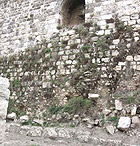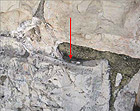|
|
Identifying the Problems and their Causes
5. Exposed core
|

|
There are sections of the Ottoman wall that were built on the remains of earlier walls. When the outside of the remains were destroyed an unstable debesh core (Fig. 25) was exposed. In these places, where stability is compromised, the danger of falling stones exists and is likely to damage the stability of the wall.
In these instances it is recommended that the debesh be stabilized by means of filling in the joints or by reconstructing the outer facades of the earlier remains. Reconstruction will only be possible in places where much information is known about the earlier wall.
|
|
6. Use of cement-based bonding material
|

|
As previously mentioned, during the twentieth century intensive work was done on Jerusalem's city walls involving the pointing up of joints using cement-based materials. This intervention resulted in irreversible damage because the cement cannot be removed without physically damaging the stone.
In the places where the joints were pointed up to a depth of 5-6 cm from the plane of the stone facade, the upper edge of the stone begins to deteriorate, dirt accumulates and there is standing water which exacerbates the weathering process (Fig. 26).
Affixing the stones with cement turned the facades of the wall into very large dirty surfaces. The temperature changes that occur along such surfaces are likely to cause cracks called thermal seams, specifically they cause the outside of the wall to swell and lacunae to form between it and the core of the wall.
The use of cement has caused irreversible damage to the building materials and has resulted in deterioration processes and damage.
Technology
|
|

|
| 25. Exposed core |

|
| 26. Use of cement-based bonding material |
|
 |
 |
|
|
| Websites, text and photos © Israel Antiquities Authority |
Powered by teti-tu |
|
|















